The Indianapolis Colts National Football League (NFL) franchise traces its lineage to December 1946, when the Miami Seahawks of the short-lived All-American Football Conference moved to Baltimore, Maryland. The rechristened “Colts” completed three seasons in the AAFC before the league merged with the NFL in 1950. The franchise went bankrupt in 1951.
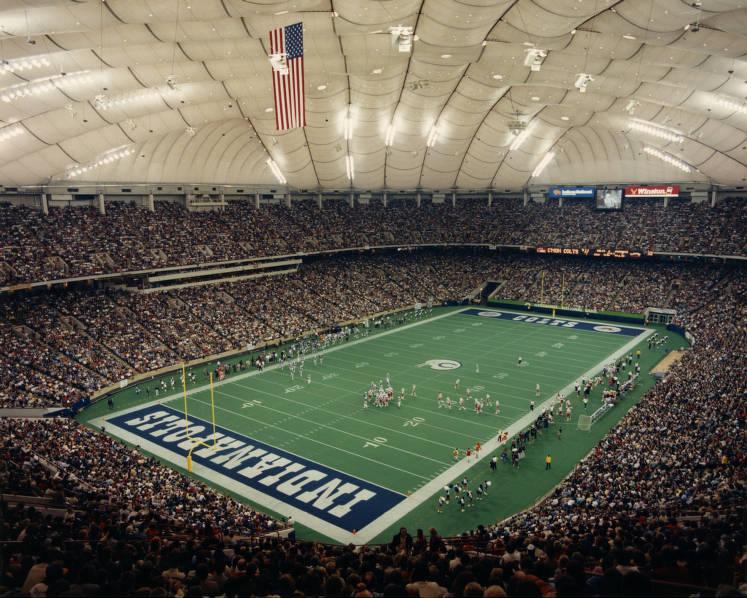
In 1953, a partnership headed by Carroll Rosenbloom, who made his fortune in a clothing business owned by his father, purchased the Dallas Texans, transferred the team to his hometown, Baltimore, and renamed it the Colts. The team soon became one of the NFL’s premier franchises. Led by coaches Weeb Ewbank and Don Shula and featuring eight Hall of Fame players, the Colts won the 1958 and 1959 NFL championships and the 1971 Super Bowl. The team finished as league runners-up in 1965, 1972, and 1975-1977. A 23-17 overtime victory against the New York Giants in the 1958 NFL title game is one of the greatest pro football games ever played, and the 1969 Super Bowl loss to the New York Jets was a pivotal game in NFL history.
In 1972, Chicago businessman Robert Irsay exchanged his ownership of the Los Angeles Rams for Rosenbloom’s interest in the Colts. Irsay’s relationship with Baltimore was less than amicable. Colts fans and the Baltimore media needed to find someone to blame for what they perceived as a decline in the team’s fortunes, while Irsay became increasingly dissatisfied with the circumstances of the team in Baltimore.
Relocation and the Early Indianapolis Era, 1984-1997
Indianapolis, meanwhile, had launched an aggressive urban renewal effort featuring sports as a primary vehicle for the city’s redevelopment. The administration of Mayor successfully endorsed a $94.7 million expansion (value of $240 million in 2020) of the that included the construction of a domed stadium. In March 1984, citing decaying facilities and decreasing attendance in Baltimore, and lured by generous financial incentives, including a guarantee by the of $7 million a year in ticket sales for the first seven years, Irsay moved his team to Indianapolis. The move, which occurred in the middle of the night of March 28, 1984, became known in sports circles as the midnight ride of the Colts.
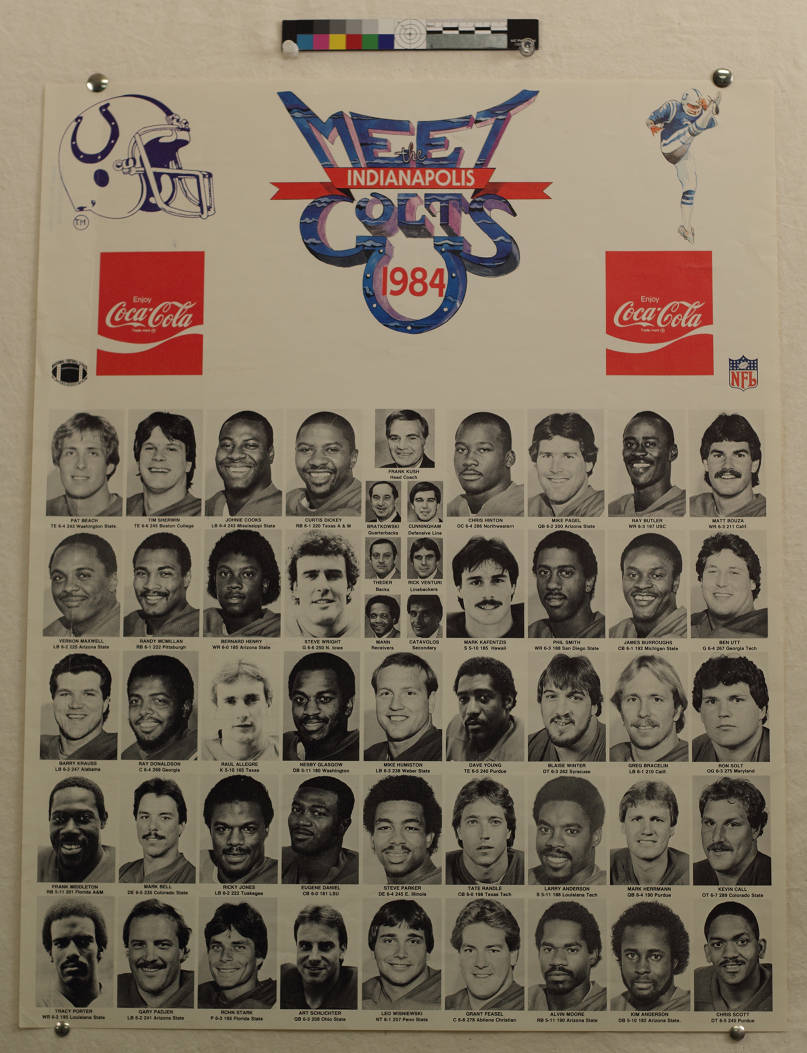
The Indianapolis Colts had an early checkered history upon moving to the Hoosier capital. In 1984, over 143,000 fans applied for season tickets. In 1989, a mediocre team drew nearly 60,000 spectators per game to the . However, a legacy of poor drafts, questionable trades, and injuries eventually resulted in non-competitive teams and an ensuing drop in attendance. In 1992, Ted Marchibroda returned to coach the Colts, 11 seasons after his first tour as the head coach of the franchise had ended. The team’s 9-7 record in 1992, following a 1-15 debacle the previous year, tied an NFL record for the greatest turnaround in one season.
Following the triumphant return of Marchibroda, the Colts continued to see success. General manager Bill Tobin brought in players like running back Marshall Faulk and quarterback Jim Harbaugh to supplement the coach’s efforts, and, by 1995, the team had played its way into the AFC Championship Game, coming within a score and a dropped Hail Mary pass of appearing in Super Bowl XXX. This success, however, did not last. By the end of the 1997 season, owner Robert Irsay had died, and the Colts had finished the season with the worst record in the league.
The Peyton Manning Era, 1998
Hoping to build the Colts back to prominence, new owner Jim Irsay, Robert’s son, brought in Bill Polian as general manager (GM) and Jim Mora as head coach. Most crucially for the future of the franchise, Polian used the No. 1 overall pick in the 1998 NFL Draft to take quarterback Peyton Manning from the University of Tennessee. In 1999, he used the fourth overall draft pick to get running back Edgerrin James, who played college football for the University of Miami. The Colts made a playoff appearance that year with a 13-3 record, and James was named Associated Press Offensive Rookie of the Year. The Colts then brought wide receiver Reggie Wayne, a University of Miami teammate of James, to Indianapolis in 2001. Mora also cultivated the talent of Manning and wide receiver Marvin Harrison, who had played at the University of Syracuse and joined the Colts in 1996. Manning, James, and Harrison all earned Hall of Fame honors after their careers ended.

Even with this talent on the roster, the Colts posted another losing record and failed to make the playoffs in 2001. Polian fired Mora following the season and brought in Tony Dungy as head coach. Formerly the coach of the Tampa Bay Buccaneers, Dungy quickly established himself as the winning ingredient that the Colts needed, leading the team to a 10-6 record and an appearance in the Wild Card round of the 2002 postseason. This began a run of unprecedented success, the first of several in which the Colts would have a successful run in the NFL, making the playoffs nine seasons in a row and win 12 or more games for seven seasons in a row.
Building off the 2002 success, the Colts acquired three future stars: Dallas Clark, recognized as a top college tight end at the University of Iowa; Robert Mathis, an outside linebacker from Alabama A&M; and Gary Brackett, a linebacker from Rutgers. The team would finish 2003 with a 12-4 record. Peyton Manning earned his first Most Valuable Player (MVP) honor as well as a run to the American Football Conference (AFC) Championship Game. The 2003 season also marked the beginning of an intense rivalry between the Colts and the New England Patriots and between their future Hall of Fame quarterbacks — Manning and Tom Brady. The Patriots beat the Colts in the regular season and again in the AFC Championship game en route to a Super Bowl victory.
The Colts repeated much of their 2003 success in 2004. Although they started 4-3, the squad went on an eight-game win streak to once again finish 12-4 and make the playoffs. Peyton Manning again was named the NFL’s MVP. Dwight Freeney, who had joined the Colts as a defensive end from the University of Syracuse in 2002, continued to develop as a player. He had set an NFL rookie record with 9 forced fumbles and was runner-up as NFL Defensive Rookie of the Year in 2002. He then led the NFL with 16 sacks in 2004. Although the Colts made the playoffs the second year in a row, the team lost again to the Patriots, 20-3, who went on to a repeat win in the Super Bowl.
In 2005, the Colts improved their record, starting the season 13-0. The team finished the season 14-2 and claimed a regular-season victory over the Patriots at New England. In the playoffs, however, the top-seeded Colts lost again to the eventual winner of the Super Bowl, losing to the Pittsburgh Steelers in the divisional round.
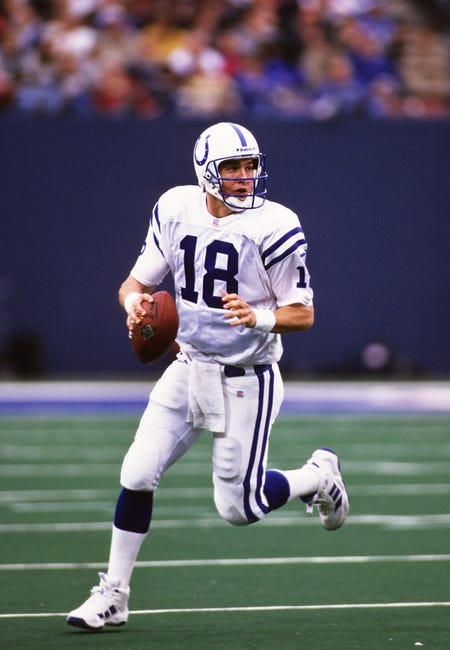
The 2006 season proved to be the most successful since the franchise won Super Bowl 5 in 1971 as the Baltimore Colts. The squad once again put together a 12-4 record to make the playoffs and defeated the Patriots again. In the postseason, the Colts won against the Kansas City Chiefs (23-8) and the Baltimore Ravens (15-6), with all 15 points coming from former Patriot’s kicker Adam Vinatieri. Indianapolis hosted the AFC Championship, in which the Colts beat the Patriots 38-34. Many consider the AFC Championship game one of the most legendary in franchise history. Down 21-3 at halftime, the Colts rallied in the second half. Scores from defensive tackle Dan Klecko and center Jeff Saturday, a quarterback sneak touchdown from Manning, a go-ahead TD run by Joseph Addai, and a game-sealing interception by Marlin Jackson enabled the Colts to advance to Super Bowl XLI.
In the franchise’s first Super Bowl appearance since the move to Indianapolis, the Colts met the Chicago Bears in Miami Gardens, Florida, on February 4, 2007. Playing in the rain, the Colts were down 14-3, before taking advantage of five Bears turnovers to win 29-17. Manning was named the Super Bowl XLI MVP, Dungy was the first African American coach to win the Super Bowl, and the Colts brought back the Vince Lombardi Trophy to Indianapolis for the first time.
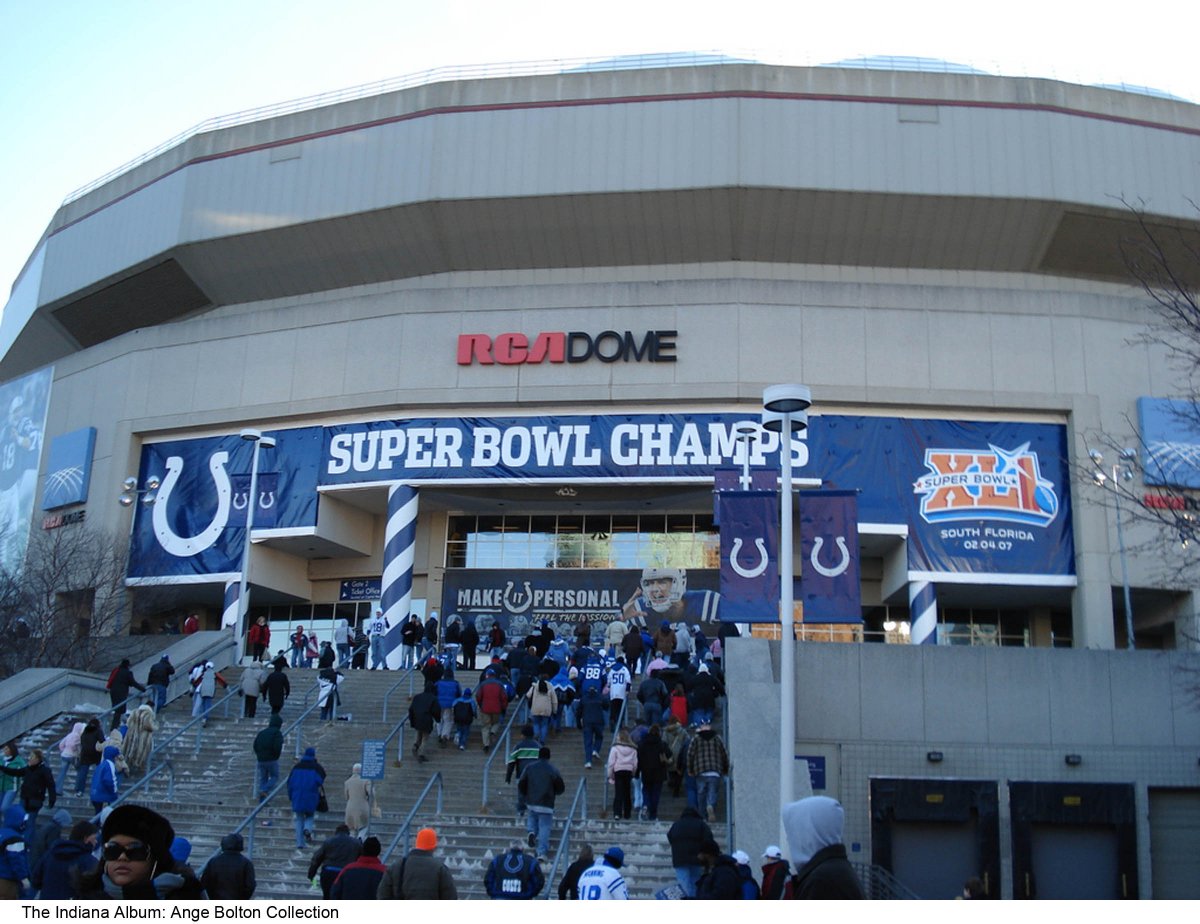
The Colts opened their 2007 campaign to defend their title with 7 straight wins, eventually going 13-3 to finish the regular season and earning a divisional-round matchup in the playoffs with the San Diego Chargers. Despite a halftime lead, the Colts lost, 28-24. Moving into the 2008 season, the Colts were grappling with two major alterations to their normal routines. The season was the first season to be played in the new home of and Manning missed most of the preseason after an offseason knee surgery.
Despite the adversity and a 3-4 start, the Colts still managed to win nine straight to finish the season, reappear in the playoffs, and see Manning earn his third NFL MVP award. As for the postseason, the results were much the same as 2007, an early exit courtesy of the Chargers. It was the last game for Dungy, who later was inducted into pro football’s Hall of Fame.
The day after Dungy’s departure, a longtime Dungy disciple and the Colts’ second consecutive African American head coach, Jim Caldwell, was named his successor. Quickly picking up the mantle of his predecessor, Caldwell led the Colts on a 2008 campaign that saw them win the first 14 games and earn Manning his fourth NFL MVP award. Despite a controversial decision to have his starters rest during the final 2 games of the regular season as opposed to pursuing an unbeaten record, Caldwell nevertheless had his team entering the playoffs as the AFC’s No. 1 seat. After dispatching the Ravens and the New York Jets in the Divisional Round and AFC Championship Game, respectively, the Colts made their return to the Super Bowl.
Once again playing for a title at Miami Gardens, the Colts faced former Purdue Boilermakers quarterback Drew Brees and the New Orleans Saints in Super Bowl 44. The Colts carried a 10-6 lead into halftime, but the game turned in the second half when the Saints opened the third quarter by recovering a surprise onside kick. The Saints scored 11 unanswered points to put the Colts down one score nearing the end of the game. Driving to the end zone with mere minutes remaining to at least tie the game, Manning threw an interception that the Saints returned for a touchdown that sealed the Saints’ 31-17 victory. The Super Bowl victory was the first in Saints’ franchise history, and Brees was named the game’s MVP.

Working to avoid the mythical “Super Bowl hangover,” the Colts’ hopes of reclaiming the AFC South title in 2010 seemed initially in doubt. With about a month left in the season, the Colts sat at a middling 6-6 and were one game behind the Jacksonville Jaguars for the lead of their division. However, a four-game win streak catapulted the team to a 10-6 record and a playoff berth. Unfortunately, the Colts would lose a close battle with the New York Jets in the Wild Card round that would send them packing for the offseason. It would turn out to be the last hurrah for the Colts as they had existed for much of the 2000s.
The Post-Manning Era, 2011-present
Manning was eventually ruled out for the duration of the 2011 season as he recuperated from neck surgery, and the offense saw a corresponding regression in its play. The team finished the season with a 2-14 record as well as the No. 1 overall pick in the upcoming NFL Draft. Seeking to recreate the magic surrounding the Colts’ last No. 1 overall draft pick (Manning), owner Jim Irsay released much of the team’s leadership in 2012 offseason. Polian was fired on January 2, 2012, and Caldwell followed just over two weeks later. By far the biggest moment of the offseason came when Irsay released Manning in March to initiate a full rebuild.
Manning hosted an emotional press conference thanking the City of Indianapolis for his time with the team. The famed Colts quarterback would go on to sign with the Denver Broncos at the end of the month, where he would eventually earn his fifth MVP award as well as a victory in Super Bowl 50.
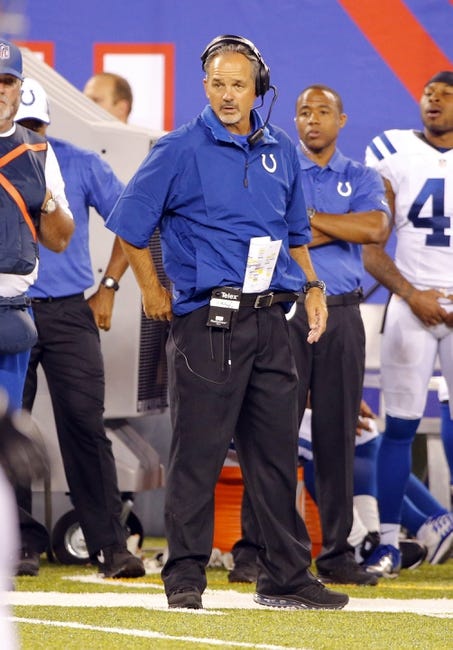
Meanwhile, the Colts initiated their rebuild by hiring Ryan Grigson as GM and defensive-minded Chuck Pagano as head coach. Building on these decisions, the Colts drafted Stanford University quarterback Andrew Luck. The moves paid immediate dividends as the team put together a dramatic 11-5 season in 2012 and a playoff appearance, a loss to the soon-to-be Super Bowl champion Baltimore Ravens. Quite possibly the biggest moments of the season came off the field, as the team and the City of Indianapolis rallied around Pagano’s battle with leukemia. Uniting under a #ChuckStrong campaign and the interim coaching of Bruce Arians, the Colts celebrated when their coach’s cancer went into remission, and he returned at the end of the regular season.
Over the next two seasons, the team continued to build around Luck and their 2012 resurgence. Bolstered by the play of individuals like up-and-coming receiver T. Y. Hilton, elder statesmen Wayne, Mathis, and Vinatieri, punter phenom Pat McAfee, and stalwart lineman Anthony Castonzo, the team put together two more 11-5 records to make the 2013 and 2014 postseasons.
Both seasons included significant matchups. In 2013, the Colts won against Manning upon his return to Indianapolis with the Broncos. In addition, that year’s postseason saw one of the most memorable games played in Lucas Oil Stadium as the Colts staged the second-largest comeback in NFL playoff history to defeat the Kansas City Chiefs at home (before eventually losing out to the Patriots in the divisional round).
The 2014 season saw the Colts make a run to the AFC Championship game, where they were eventually crushed 45-7 by the Patriots. The Colts had defeated the Cincinnati Bengals and knocked off Manning’s Broncos in Denver to reach the AFC title game. The game, which the Patriot won, sparked the NFL’s infamous “Deflategate” debacle, wherein Tom Brady was suspended for four games for ordering Patriots staff to deflate regulation footballs to gain a slight advantage.
An inability to consistently build the team as well as a rash of Luck injuries that led to reduced playing time resulted in two straight 8-8 seasons, followed by a 4-12 season. In all three seasons, the team failed to advance to the playoffs. As a result, Grigson was fired following the 2016 season, and Pagano followed his path out the door after the 2017 season. Filling these gaps, Irsay hired Chris Ballard as general manager in 2017 and Frank Reich as head coach in 2018. Reich was coming off a Super Bowl LII victory as the Philadelphia Eagles offensive coordinator.
These changes along with Ballard’s drafting of future Colts stars in offensive guard Quenton Nelson and linebacker Darius Leonard helped the squad overcome a 1-5 start to finish 10-6 and return to the playoffs. The team beat their AFC South rival Houston Texans to advance to the divisional round of the playoffs before they were knocked out of the 2018 postseason by the Kansas City Chiefs.
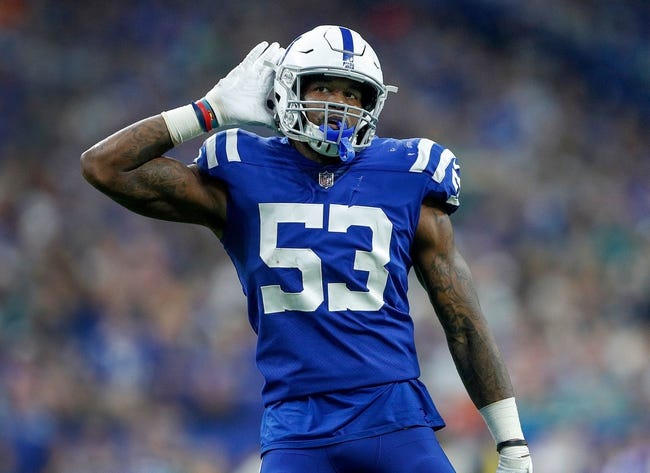
Weeks before the start of the 2019 season, the oft-injured Luck announced that he would be retiring from the NFL, citing a loss of enthusiasm for the sport. A string of losses in the second half of the year left the team with a 7-9 record and missing the playoffs once again.
Ballard and Reich spent the offseason making numerous acquisitions that would bolster the roster, such as trading for all-star defensive tackle DeForest Buckner and drafting running back Jonathan Taylor. The reloaded roster, featuring former Charger’s quarterback Philip Rivers, made 2020 playoffs before narrowly losing 27-24 to a resurgent Buffalo Bills squad in the wild card round. Rivers retired following the season, and the Colts acquired Philadelphia Eagles quarterback Carson Wentz, who in 2021 reunited with Reich from their Super Bowl-winning days.
Colts’ Impact on Indianapolis
By establishing itself once again as a premier NFL franchise, the Colts have had a significant impact on Indianapolis. They have been an anchor in the city’s economic development strategy of using sports and events to revitalize the downtown. Lucas Oil Stadium, one of the nation’s premier stadiums, stems from the city’s controversial decision to build it or risk losing the franchise. The convention center expansion, the city’s reputation for staging large events successfully, the emergence of a noted restaurant culture, and the revival of the downtown owes part of its success to the Colts. Perhaps the most notable change, however, has come in how Indianapolis, once a basketball-centric place, views itself as a major-league football city, with the emphasis on both football and major league.

Help improve this entry
Contribute information, offer corrections, suggest images.
You can also recommend new entries related to this topic.